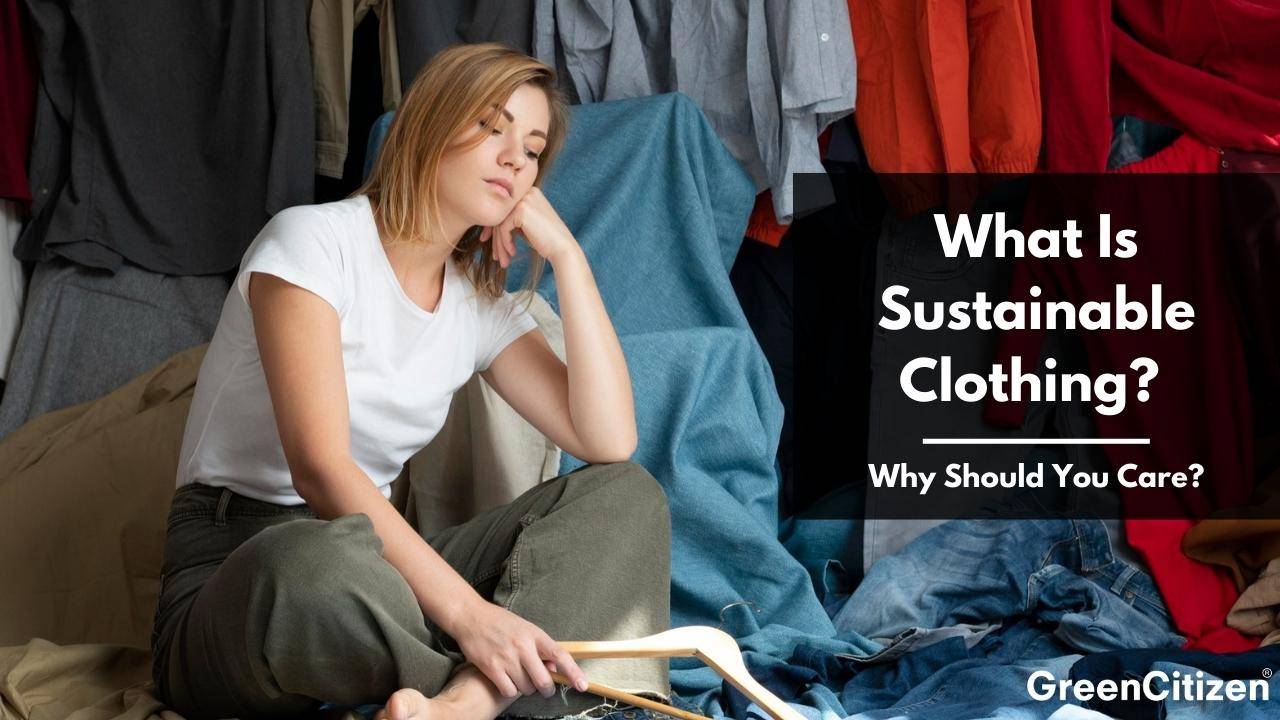The fashion industry is the second-largest polluter after the oil industry, emitting 2.1 billion tons of CO2 every year.
And that’s just for starters.
Fast Fashion companies reap enormous profits by using plastic fibers that easily end up in the food we eat.
At the same time, they rely on cheap and unsafe labor in developing countries, with little regard for workers’ well-being or the treatment of animals.
This has to end. We need a massive change across the entire industry.
The good news is that more and more ethical and sustainable clothing brands are helping create awareness and taking an active role in making a change.
What is Sustainable Fashion?
Sustainable fashion is an umbrella term used to describe products, processes, activities, and decision-makers involved in creating a carbon-neutral fashion industry.
But there’s more to it than that
Sustainable Fashion promotes equality, social justice, animal welfare, and ecological integrity.
Sustainable fashion insists on locally sourced and produced garments, a transparent supply chain, traceable work processes, and raw materials, safe working conditions, and fair wages.
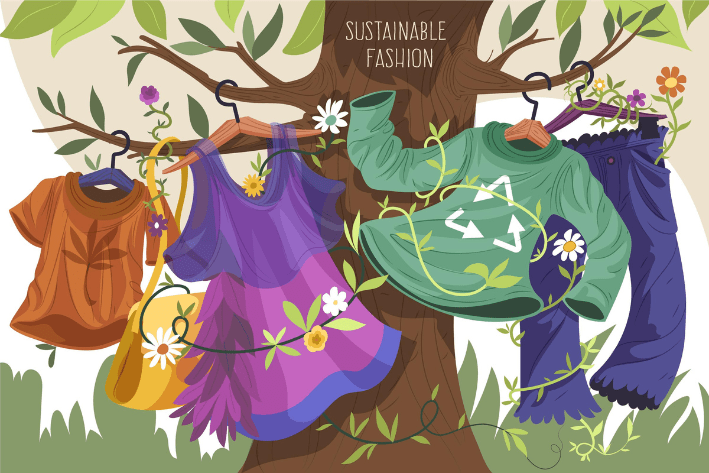
First, let’s get this straight — there’s no such a thing as zero-impact clothing. There’s always some negative impact on the environment.
However, there are brands that are set to make a difference. While some brands focus on one or two sustainability issues, others manage to tackle more of them.
The problem is that there’s no regulation on the term “sustainable fashion”. In an industry that is already murky, some brands are being dishonest about their environmental efforts.
This is known as greenwashing, manipulative tactics to promote sales without even trying to run a truly sustainable business.
So how can you spot truly sustainable clothing brands?
Start with those who put an emphasis on transparency in their supply chains. Also, keep an eye out for partners and standardized certificates that stand behind sustainability claims.
These include:
- GOTS — The Global Organic Textile Standard that certifies organic cotton.
- GRS — Global Recycled Standard that certified recycled content claims.
- LEED certification for reduced energy use in factories.
- Bluesign for chemical and environmental management.
You should also look for Certified B Corporations that meet highly regulated standards measuring a company’s environmental impact.
Sustainable fashion is sometimes referred to as “slow fashion”.
While fast fashion brands capitalize on cheaply made clothes for short-term use, slow fashion takes into account the full lifecycle of the product — from materials sourcing and design to the manufacturing process to the end of life.
Impacts of Fast Fashion: The Root of All Problems
While climate change, deforestation, and plastic pollution grab the headlines, the fashion industry typically doesn’t raise any red flags.
Still, I have to break out the bad news — the clothing industry is a serious source of pollution and carbon emissions.
The good news is that sustainable fashion is moving to address many of these issues.
So what are we exactly dealing with?
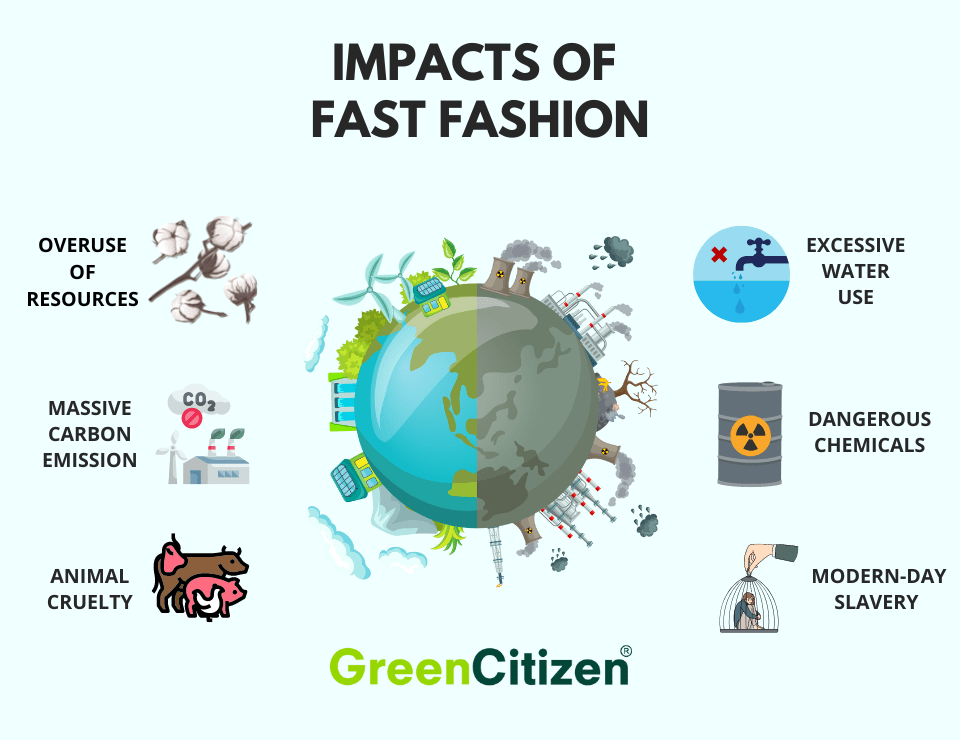
6 Reasons Why Sustainable Clothing is Important
Sustainable or ethical clothing brands aim to solve the environmental and ethical issues that we commonly associate with the industry.
Here’s what ethical fashion brands can do for our planet.
Preserve Natural Resources
Recycled fibers are a much more sustainable option than virgin resources. Recycled garments reduce pressure on new resources and take a lot of waste out of the equation.
Just consider this:
For every 10,000 tons of ECONYL®, raw materials used to make swimwear, the industry can save 70,000 barrels of oil and 57,100 tons of CO2 compared to virgin nylon.
Cut Carbon Footprint
Eco-friendly clothing brands often use materials made of natural or recycled fabrics that require much less or even no chemical treatment.
On top of it, recycled fabrics need much less water, less energy, and no fertilizers or pesticides to grow.
As a matter of fact, most organic fibers such as hemp, linen, and organic cotton are biodegradable. For example, TENCEL™ is a biodegradable material made of sustainably-harvested wood pulp.
Save Animal Lives
Sustainable clothing brands have also started embracing cruelty-free alternatives.
Piñatex, one of the most demanded leather alternatives is made from cellulose fibers of pineapple leaves that are discarded in the harvesting process.
Faux leather is made of polyester that comes from plastic trash from the oceans, bags are made from recycled seatbelts, while Reebok has launched plant-based compostable sneakers made of eucalyptus, algae, and castor beans.
Instead of natural silk, some eco-conscious clothing brands use an alternative made from yeast, and there’s also 100% vegan bio fabricated wool.
In truth, there’s an ethical alternative for every animal-sourced material.
Conserve Water
In comparison with conventional cotton, organic cotton reduces water consumption by 91%. Still, only 1% of global cotton production is currently organic.
One of the reasons is a much higher cost of non-GMO seeds, which require extra investments in material and machinery that growers only use for organically grown crops.
But cotton is not alone. There are other sustainable fabrics that need very little water in the production phase, like linen, hemp, and REFIBRA™, which is made from upcycled cotton scraps from pre and post-consumer cotton waste.
Protect the Environment
Some of the chemicals used to treat fabrics pose a danger to our health as our skin absorbs anything that comes in contact with it.
Always wash new clothes before putting them on for the first time. If you want to be safe, look for items with chemical content certification labels such as BLUESIGN®, GOTS, or OEKO-TEX®.
Create Fair and Safe Working Conditions
Ethical fashion brands insist on humane working conditions, health care, and fair wages for their workers, which are often above average.
They show initiative towards creating economic opportunities in impoverished or disaster-stricken regions and actively participate in campaigns to end poverty.
An important part of feeling great about our clothes comes from knowing that the pieces were made under fair conditions and care for the well-being of workers and their families.
8 Types of Sustainable Clothing Trends
As mentioned, sustainable fashion is an all-inclusive term with many branches that have one thing in common — eliminate or reduce the environmental and social impact of the fashion industry.
Here’s how sustainable clothing brands combat fast fashion:
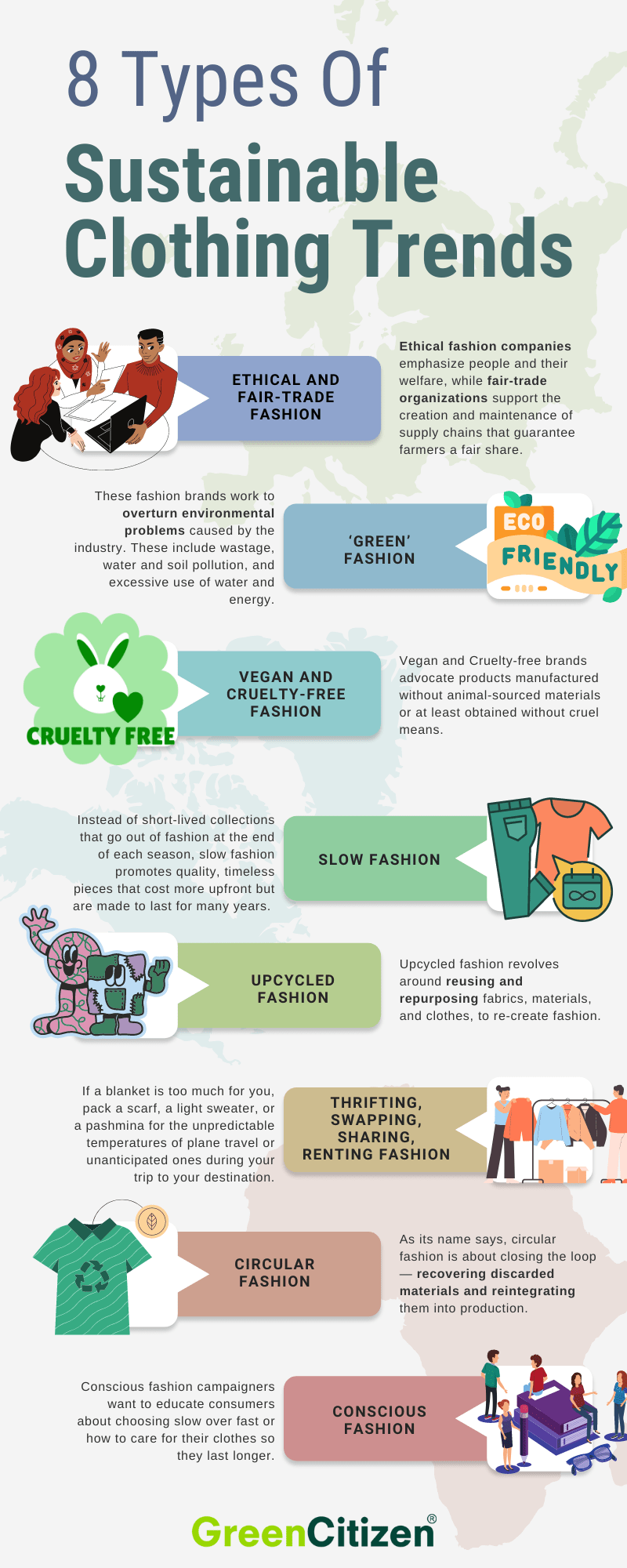
Ethical and Fair-trade Fashion
These brands focus their mission on improving the welfare of people working in the industry. They tackle issues like child labor, gender rights, safe working conditions, and fair-trade manufacturing.
Ethical fashion companies emphasize people and their welfare, while fair-trade organizations support the creation and maintenance of supply chains that guarantee farmers a fair share in exchange for their products.
Eco-friendly or ‘Green’ Fashion
These two terms are used to describe fashion brands that work to overturn environmental problems caused by the industry.
These include wastage, water and soil pollution, and excessive use of water and energy that contribute to climate change.
Here’s the elephant in the room: Over 90% of clothing brands still use plastics and other non-biodegradable fibers that continue polluting our oceans.
In a vicious circle, over 70 million barrels of oil are used to make polyester fibers, which eventually find their way into oceans where they enter the food chain.
Green fashion companies, on the other hand, strive to replace plastics with biodegradable and natural fibers that are compostable. Instead of killing it, these fabrics feed the environment.
A number of companies are successfully using eco-friendly alternatives like hemp, mushroom leather, kelp leather, organic cotton, etc.
Vegan and Cruelty-free Fashion
Vegan and Cruelty-free brands advocate products manufactured without animal-sourced materials or at least obtained without cruel means.
In addition, vegan and cruelty-free campaigners work toward increasing awareness of industrial animal farming and animal exploitation for fashion.
Yet, these campaigners often tread on uneasy ground, as there are arguments that vegan fashion causes more damage than good.
One of these arguments is that the majority of vegan fashion brands approved by PETA use PVC and plastic-based alternatives to animal leather.
This is a real problem — while saving animals from killing, these materials harm them in other ways, by polluting their environment.
In recent years, advocates of the vegan fashion movements insist that vegan clothing brands can qualify as sustainable only if they pay attention to this aspect of environmental impact as well.
The solution is to ditch plastic alternatives for biodegradable fibers made from plants, fruits, and mushrooms.
Slow Fashion
This term has lately been used to describe the way fashion is manufactured.
In contrast to fast fashion, which relies on mass manufacturing on an industrial scale, slow fashion is created by expert artisans.
The idea behind the slow fashion movement is that the use of virgin materials and wasteful manufacturing practices are not the only problem in the fashion industry today.
Fashion consumption also comes into play.
Instead of short-lived collections that go out of fashion at the end of each season, slow fashion promotes quality, timeless pieces that cost more upfront but are made to last for many years.
Upcycled Fashion
Upcycled fashion revolves around reusing and repurposing fabrics, materials, and clothes, to re-create fashion.
Old fabrics get their unique properties with usage and wear, so upcycled fashion is part of adding uniqueness to the final product. Something you can’t replicate on an industrial scale.
This guarantees that every final piece is authentic.
However, not everyone thinks upcycled fashion is too relevant for the whole sustainability story.
On one hand, upcycled materials have many PROS:
- Helps reduce waste
- Reuses existing materials
- Cuts carbon from manufacturing & transport
On the other, there are some standing CONS:
- Upcycled clothes release twice as many microfibers that enter food chains
- Upcycling uses more energy and chemicals than new manufacture
One way or another, this branch of sustainable fashion is immensely popular among contemporary designers and celebrities alike. To some, it’s becoming a new facet of high-end luxury fashion.
Thrifting, Swapping, Sharing, Renting Fashion
This one is my personal favorite, as I’m an avid visitor of thrift stores and second-hand shops.
Buying or swapping used clothes is a great way to avoid the negative impact of fashion.
The best thing is that these garments already exist and there’s no need to manufacture or upcycle them again. There are no toxic chemicals, no greenhouse gases, and no pesticides.
Still, there’s a downside to second-hand and vintage fashion that people rarely talk about:
It’s sometimes difficult to assess the quality and condition of the clothes you want to buy.
With wear and use, items made of animal leather or plastic will start leaching toxic chemicals on your skin.
After some time, these compounds can affect your hormonal balance, which shows on your skin, hair, nails, etc.
Circular Fashion
As its name says, circular fashion is about closing the loop — recovering discarded materials and reintegrating them into production.
The most popular form of a closed-loop system is the recycling of polyester and other plastic materials and using them to produce new synthetic fibers.
Conscious Fashion
Probably the most popular example of sustainable fashion, conscious fashion is the consumers’ way to respond to issues caused by fast fashion.
But how does it work?
The environmental impact of fashion much depends on consumers’ choices. Due to fast fashion trends, garments are with half as much when compared to 15 years ago.
This is primarily due to lower product quality and our desire to own the latest trends.
So, conscious fashion campaigners want to educate consumers about choosing slow over fast or how to care for their clothes so they last longer.
For example, two-thirds of the total energy that a pair of jeans consume during its life goes into washing and drying.
It’s even more dramatic with underwear — 80% of the total energy is spent on the laundry.
No matter how sustainable your clothes are, washing requires water, energy, and detergent.
You don’t have to dump all the clothes in the washing machine every Saturday night like Sheldon Cooper. (Saturday night is the laundry night)
Let me share some of my tips:
- I have a habit of airing my clothes after wearing them. It works miracles, especially for garments made of wool. Just hang them outside overnight and fresh air will remove odors and make your shirts feel fresh again.
- If you need to deodorize your jeans, you can do it without washing — just freeze them. It works great for removing gum, too.
How to Combat Fast Fashion As a Consumer?
We as consumers can use our buying power to make a difference. Every time you make a purchase you’re voting in favor of the type of products you want to see made.
This translates to voting for the kind of world you want to live in.
So what can we do?
Don’t Buy Clothes at All!
You know that great feeling when you get out of a mall and you’re happy because you didn’t buy anything but you saved all the cash?
Making do with what you already have is the most sustainable fashion buying decision.
We need to change the way we think about things we wear.
Instead of treating garments like disposable items that get worn out sooner or later, treat them as prized possessions and you can bet they’ll last longer.
Borrow, Swap, or Buy Second Hand
Swapping clothes with friends is a great way of closet shopping. You can freshen up your style without spending any money, and more importantly, without paying for new manufacturing.
Get a group of friends and make a clothes swap event.
On the other hand, if you like buying clothes, at least pledge never to buy new ones.
There’s an entire world of great second-hand clothes you can get at bargain prices.
You love ripped jeans?
Why shouldn’t those rips be for real?
By giving second life to garments, you can be fashionable and sustainable all at once.
If you don’t have great thrift stores close to where you live, you can try some of the best online thrift stores. It’s much more elegant than rummaging through someone’s closet, eh?
But if You Have to Buy New…
You should do it consciously.
Whether it’s a pair of sneakers or denim, I always look for classic designs that won’t go out of fashion so easily.
Also, I tend to buy items that mix and match well with one another. This especially comes in handy when traveling — with a few select pieces, I can make several looks that are never dull.
Quality also plays an important part. Look at the stitching. If the seams are messy or unfinished, give it a pass.
What Makes a Fashion Brand Sustainable?
With so many true and false claims, it’s getting increasingly hard to spot a truly sustainable fashion brand.
To help you always make the right choice, I’m going to share the tips I use when choosing eco-friendly.
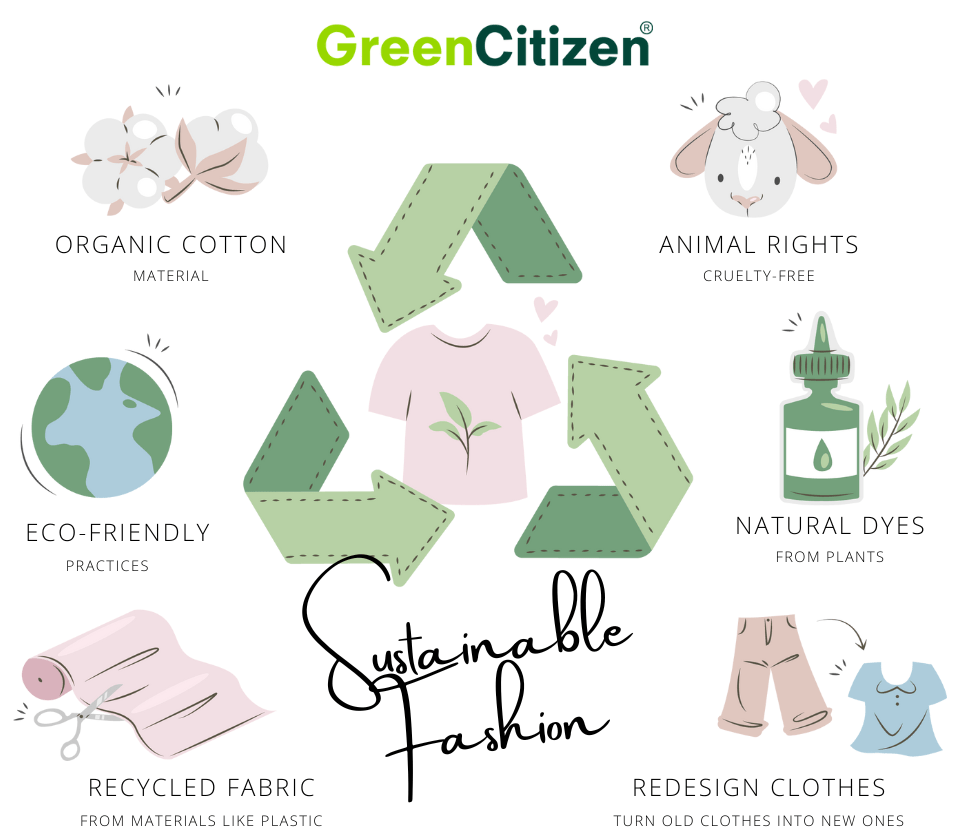
Natural Fabrics & Dyes
Natural fibers like organic cotton require minimal processing. It’s grown and processed without pesticides and artificial fertilizers. Organic cotton also has certifications that ensure that farmers are paid and treated fairly.
Organic bamboo is another fast-renewing fiber you should look for. It needs only rain to grow and traps more carbon dioxide than hardwood trees!
Small & Transparent Supply Chain
While having full transparency across the entire supply chain is a bit unrealistic, at least I like to know who makes my clothes.
Smaller supply chains are always more transparent and have fewer unknown variables.
So how can you tell that a company does it right on the supply chain?
- Products are manufactured locally.
- Products are manufactured in developed countries that have strict workplace health and safety regulations, plus adequate wages
- The small product line — Large offerings and choice of materials require a large supply chain that is hard to control. Notice how quality brands don’t need to offer a huge array of garments. The problem is that we are spoiled by one-stop-shop convenience.
- Small, family-owned fair trade clothing business
Ethical Fashion Certificates
It would be impossible for consumers to investigate every single fashion brand. Luckily, others have already done it for us.
The safest way to see if an apparel company is greenwashing you is to look for certificates from third-party audits.
Although these are non-mandatory, they speak a lot for companies that took the effort to obtain them.
The two most important ones are:
- B-Corp: A top-tier all-inclusive certification for both ethical and sustainable business practices. To get it, a company must prove high standards across 80 different impact areas, including the entire supply chain. To keep the B-Corp badge, a company needs to take an audit every year. This one is no joke!
- Fair Trade: To get this certificate, a business needs to get approval from lots of different certifying bodies, such as the World Fair Trade Organization, North American Fair Trade Federation, Fair Trade USA, Fairtrade Foundation, and Fairtrade International. Can’t cross those.
Inclusive & Diverse Image
Finally, when judging the human rights side of the fashion industry, I like to endorse brands that are size inclusive and underline diversity in their product campaigns.
Will you agree with me that fashion catalogs that feature only great-looking models need to become a thing of the past?
Let’s see how the garments look on different body types, sizes, skin tones, etc.
What Are Some Sustainable Clothing Brands in the Market?
Now let’s take a look at some of the best sustainable clothing brands.
ABLE
This brand aims to help end cyclical poverty by creating economic opportunities for people to provide for themselves. Their eye-catching bags and denim staples are made all over the world by fairly paid women, some of whom have overcome great difficulties.
ABLE offers free virtual styling, a try-before-you-buy program, free returns, and free exchanges for any size fluctuations within a year.
Ethics: B-Corp, fair labor practices and wages, empowering women
Patagonia
This company is one of the earliest champions of environmental ethics in the industry. It is also one of the first to use recycled materials and organic cotton. Committed to labor ethics, Patagonia partners with US factories as often as it can, ensuring a controlled supply chain.
Since they produce only quality gear, they had no difficulties setting up the secondhand Worn Wear program.
Ethics: B-Corp, Fair Trade, organic cotton & recycled materials, a secondhand shop
Everlane
Known for clothing, shoes, and accessories that are made to last, Everlane is committed to meeting the goals of the Paris Agreement by lowering carbon emissions to net-zero by 2050. It has also pledged to remove all virgin plastic from its supply chain by the end of 2021.
Currently, all of its shipping bags are made from recycled plastic or FSC-certified paper.
Ethics: GOTS, recycling, net-zero
Organic Basics
As its name suggests, this brand has sustainability woven into its core values. To make garments last, this company invests in quality fabrics and craftsmanship while keeping items versatile. Organic Basics offers a huge collection of basics, as these pieces are the easiest to wear. The company partners with ethical European factories that guarantee a safe working environment and living wages.
Ethics: Organic fibers, fair labor & wages
tentree
Relying on sustainable and comfortable materials, tentree produces eco-friendly essential garments for the whole family. Its name comes from a commitment to plant 10 trees for every item purchased — 73 million trees to date and counting!
Its lifestyle and loungewear are designed in Canada and manufactured ethically worldwide.
Ethics: B-Corp, Climate Neutral Certified; WRAP, BSCI, SA8000, or Fair Trade
Levi’s
One of the sustainable clothing brands men and women have been wearing since the day of the Gold Rush. Levi’s has always been at the frontier of change of progress. These days, the company is applying eco-friendly practices like recyclable denim, ethically sourced cotton, and water-saving technologies.
Ethics: Some sustainable fabrics, inclusive sizing, a secondhand shop
Fair Indigo
When shopping for sustainable clothes I always look for pieces that are quality-made and built to last. Fair Indigo totally agrees, as their Forever Organic Tees are guaranteed to last up to five years! The collections are made with organic Peruvian cotton that is family-grown and harvested by hand.
Ethics: GOTS, safe dyes, fair wages, artisan-made, gives back via Fair Indigo Foundation
Tradlands
Let’s make high-quality sustainable women’s clothing by taking inspiration from classic menswear. This formula seems to have worked brilliantly since Tradlands goods are now a staple in any capsule wardrobe. The brand puts a lot of emphasis on fit, details, and quality while ensuring that every piece is sustainably made.
Ethics: Ethical production, small-batches, secondhand, natural & deadstock materials, inclusive sizing
EILEEN FISHER
This brand is one of the leaders in a sustainable fashion. Social and environmental injustices are reason enough for EILEEN FISHER to approach business differently. The company is in control of its entire supply chain to ensure fair wages all along. The brand is also one of the pioneers of circular systems — they gladly take back old pieces and use them to make new apparel.
Ethics: B-Corp, Fair Trade, circular & secondhand programs
Sotela
The idea is that our bodies change and fluctuate in size every single day. For this reason, Sotela wants you to celebrate your body in all its forms and phases. Instead of merely offering plus-size dresses, Sotela maintains a line of body-positive women’s apparel that uses flexible sizing. This way you can look relaxed and confident in any situation. Shipped in recycled packaging.
Ethics: Made in the USA, organic materials, recycled packaging, inclusive sizing.
Final Thoughts
Throughout history, men and women of style have always stated that “Less is More”.
Nowadays, this motto strongly applies to the fast fashion industry:
It siphons money from your pocket by always making you want the latest pieces, YET it creates mountains of waste while devouring excessive amounts of virgin raw materials, fossil fuels, and water.
In return, this highly unsustainable industry leaves pollution and disadvantaged communities of farmers and factory workers that toil in unsafe conditions while making ends meet on minimum wages.
You have the power to change things.
Start adopting sustainable clothing habits today.
This way you’ll support brands that conserve resources and care about fair labor practices.
Help them win the unfair competition and score one for the planet!

